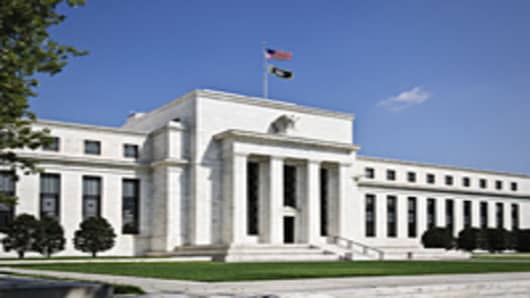The Fed Wednesday is likely to give a nod to an accelerating U.S. economy but also make clear that the improvement is not strong enough to end its easing policies.
"I think that statement tomorrow will be acknowledging the growth outlook is better, but I think it will reiterate that the labor market is still pretty soft and inflation is pretty low," said Deutsche Bank chief U.S. economist Joseph LaVorgna.
The Fed winds down its first meeting of 2011 with a 2:15 p.m. statement Wednesday. The Federal Open Market Committee is expected to be a more hawkish group this year, as two outspoken Fed Presidents, Richard Fisher of Dallas and Charles Plosser of Philadelphia, have rotated into the group of voting members.
Neither is expected to dissent at this meeting, but they are likely to become more vocal as the year goes on. Pimco senior strategist Tony Crescenzi notes that Fisher has said he expects the Fed's current quantitative easing (QE) program to be continued to completion. Under the program, approved in November, the Fed will purchase $600 billion in Treasury securities through the second quarter of the year.
"Plosser though has said things a little differently, much more hawkish. If there's a candidate more likely to dissent, it would be he but maybe not in this go around. Right now, it's not expected, but it's possible," Crescenzi said.
The Fed's behind-the-scenes discussion is really of more interest to market participants who have been watching to see if the Fed will signal it is expecting to complete the program, end it early or even extend it.
"In the minutes of the December meeting, it said there was a high threshold for ending the program early, so we would expect that since nothing has come along to question whether the Fed should continue to engage in that, most of what was said will stay in place. The Fed will indicate the program will continue and it would be scaled to economic and financial conditions," Crescenzi said.
The Fed has been criticized for QE, which was expected to keep rates low and push other asset classes higher. It has succeeded in creating an environment where stocks and commodities have risen, and the dollar has moved lower but rates have fluctuated. The 10-year was yielding 3.33 percent Tuesday, above where it was when Fed Chairman Ben Bernanke first mentioned quantitative easing in August.
"If you take them at their word, it's somewhere around 25 basis points that rates have been dampened by the balance sheet" expansion, LaVorgna said. "So maybe (10-year) rates would be 3.50/3.60ish but who knows? The problem with QE2 is the benefits of the plan are not obvious."
LaVorgna said the problem could come when the Fed moves to unwind its easing stance, especially if it continues to keep monetary policy too loose for too long a time. "Whenever they reverse course, that's a real risk to the financial system," he said, adding the markets will react negatively and the economy could take a hit.
LaVorgna said the Fed may start tightening by year end, but for now, it will hold steady.
"I think the statement could be equity friendly. You're going to see a statement that acknowledges the economy is better, but they're not going to come off the gas pedal yet. To me, that's going to be constructive for risky assets," LaVorgna said.
The Fed has purchased about $250 billion in Treasury securities, according to Jefferies Treasury strategist John Spinello. That includes Treasury securities the Fed is also purchasing with the proceeds from the maturing mortgage securities in its portfolio.
Spinello is watching the Fed statement but says he's also watching the 1 p.m. auction of $35 billion in 5-year notes. "It's been shown that 5-year note auctions on the day of Fed meetings don't go all that well. If the (bond) market sells off, and (the Fed) doesn't say anything destructive, it will rally," he said.
Questions? Comments? Email us at marketinsider@cnbc.com



